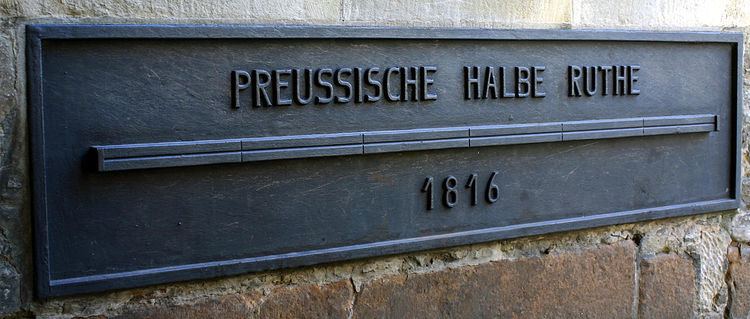 | ||
The obsolete units of measurement of German-speaking countries consist of a variety of units, with varying local standard definitions. Some of these units are still used in everyday speech and even in stores and on street markets as shorthand for similar amounts in the metric system. For example, some customers ask for one pound (ein Pfund) of something when they want (exactly) 500 grams.
Contents
- German system
- Meile mile
- Rute rod
- Wegstunde
- Klafter fathom
- Lachter
- Elle ell
- Fu foot
- Zoll inch
- Linie
- Klafter
- Nsel
- References
The metric system became compulsory on January 1, 1872, in Germany and on January 1, 1876, in Austria.
Some obsolete German units have names similar to units that were traditionally used in other countries, and that are still used in the United Kingdom (imperial units) and the United States (United States customary units).
German system
Before the introduction of the metric system in German, almost every town had its own definitions of the units shown below. Often towns posted local definitions on a wall of the city hall. For example, the front wall of the old city hall of Rudolstädt (still standing) has two marks which show the "Rudolstädter Elle", the proper length of the Elle in that city. Supposedly by 1810, in Baden alone, there were 112 different standards for the Elle around Germany.
Meile (mile)
A German geographic mile (geographische Meile) is defined as 1⁄15 equatorial degrees, equal to 7,420.54 m (24,345.6 ft). A common German mile, land mile, or post mile (Gemeine deutsche Meile, Landmeile, Postmeile) was defined in various ways at different places and different times. After the introduction of the metric system in the 19th century, the Landmeile was generally fixed at 7,500 m (24,606 ft) (the Reichsmeile), but before then there were many local and regional variants (of which some are shown below):
Rute (rod)
The Rute or Ruthe is of Carolingian origin, and was used as a land measure. Many different kinds of Ruthe were used at various times in various parts of the German-speaking world. They were subdivided into differing numbers of local Fuß, and were of many different lengths. One source from 1830 lists the following:
Wegstunde
One hour's travel, used up to the 19th century. In Germany 1⁄2 Meile or 3.71 km (2.31 mi). After 1722 in Saxony 1⁄2 post mile = 1000 Dresden rods = 4531 m. In Switzerland 16,000 ft or 4.88 km.
Klafter (fathom)
Originally 6 feet, after introduction of the metric system 10 feet. Regional variants from 1.75 m (5 ft 9 in) in Baden to 3 m (9 ft 10 in) in Switzerland.
Lachter
The Lachter was the most common unit of length used in mining in German-speaking areas. Its exact length varied from place to place but was roughly between 1.9 and 2.1 metres (6 ft 3 in and 6 ft 11 in).
Elle (ell)
Distance between elbow and fingertip. In the North, often 2 feet, In Prussia 17⁄8 feet, in the South variable, often 2 1⁄2 feet. The smallest known German Elle is 402.8 mm (15.86 in), the longest 811 mm (31.9 in).
Fuß (foot)
The Fuß or German foot varied widely from place to place in the German-speaking world, and also with time. In some places, more than one type of Fuß was in use. One source from 1830 gives the following values:
Zoll (inch)
Usually 1⁄12 foot, but also 1⁄11 and 1⁄10.
Linie
Usually 1⁄12 inch, but also 1⁄10.
Klafter
For firewood, 2.905 m3 (102.6 cu ft)
Nösel
In general, the Nösel was a measure of liquid volume equal to half a Kanne ("jar," "jug," "bottle," "can"). Actual volumes so measured, however, varied from one state or even one city to another. Within Saxony, for example, the "Dresden jar" held approximately 1 US quart or 0.95 litres or 0.83 imperial quarts, so a nösel in Dresden was about 1 US pint (0.47 L; 0.83 imp pt). The full volume of a "Leipzig jar" measured 1.2 liters (1.3 U.S. qt; 1.1 imp qt); the Leipzig nösel was therefore 0.6 liters (0.63 U.S. qt; 0.53 imp qt).
The nösel was used in minor commerce, as well as in the household to measure meal, grain, and such. These units of measure were officially valid in Saxony until 1868, when the metric system was introduced. Nevertheless, the old measures have continued in private use for decades.
One interesting modification was introduced in Thuringia. There, the nösel was, by extension, also a measure of area; namely, the area of land which could be sown with one nösel of seed — or about 19.36 square yards (16.19 m2; 0.00400 acres)
